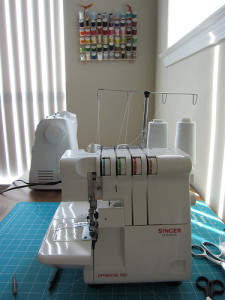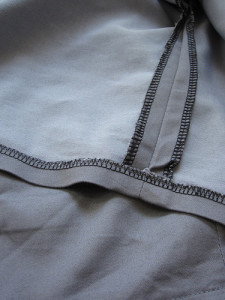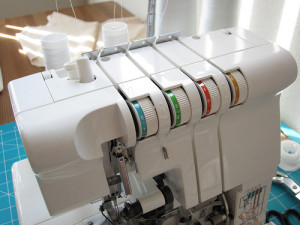Do I really need a Serger?
I’m introducing a new series on the blog called Do I really need…? where I give my opinion on the pros and cons of something sewing or craft related. I’m hoping this will be a once a week feature. If you have any ideas for future Do I really need? posts tell me in the comments! So, onward we go –
Do I really need a serger? I’ve heard this question asked often on the internet by beginner or intermediate sewers who want to take their sewing to the next level and it’s a good thing to consider.
The short answer is no, not really. The long answer is, well, maybe. It depends on what you want to do with your sewing and what benefits a serger can give you.
A serger or overlock machine is like a sewing machine with three or four threads that wrap around the edge of fabric and prevents it from fraying. Look inside any store bought garment and you’ll see a serged edge.
This isn’t going to be a post about what brand or features to look for when buying a serger. If you’re still contemplating whether you need one then we haven’t gotten far enough to go on a shopping trip.
First, ask yourself a few questions:
– How serious am I about sewing? Do you want to make clothes that look like ready to wear from the store or are you fine with quick and easy cotton skirts? Do you sew mostly clothes for yourself and others or are you more into crafts and home decorating projects? Do you want to sell your clothes like on Etsy or is it purely a hobby?
If you answered yes to the former halves of those questions maybe you should consider getting a serger. If you plan on selling clothes a serged edge looks professional and is easier and faster to do than a French seam, for example. If you’re making clothes for your kids on the other hand, they’ll probably out grow the clothes so fast that taking some pinking shears to the seams allowances will be fine.
– Are you sewing with knits?
Yes, you can totally get away with using a zig zag or stretch stitch on your regular machine for knits but if you sew knits often (like me!) a serger is the way to go. With knits a serger is incredibly quick and easy to sew seams.
– How lazy are you?
This question can go either way. Because a serger sews and finishes the edge in one fell swoop it can make you a speed queen! Hemming a skirt is faster when you serge the raw edge then fold under once and top stitch rather than folding and measuring and pressing the hem twice to enclose the edge. You can sew shoulders one after the other without stopping and clipping dangling strings.
But there are still times when it is important to sew a seam with a sewing machine first. In that case you would take more time to serge the edges either together or by opening up the seam and serging either side individually as compared to just using pinking shears. I don’t always use my serger on seams for that reason.
Also, while threading a serger is not the 7th level of hell that people often make it out to be, it is annoying and time consuming and you’ll probably need a pair of tweezers handy. Changing colors on my serger has definitely weighed in on my decision to serge an edge or not…
What can a serger do that my sewing machine can’t and does that matter?
One thing a sewing machine can’t do – rolled hem. If you ever have to work with very delicate fabrics, something flimsy and slippery and sheer, you’ll appreciate the rolled hem feature. It is basically what it sounds like, a tight overlock stitch that rolls the hem in on itself ever so slightly. It makes a great finished edge for bridal gowns and fancy dresses. A serger can also do things like gather or stretch the edge of a fabric, pretty cool when you’re doing a flounce or ruffles. If you buy what’s called a cover stitch machine you can make those double top stitches you find on the hems of your t-shirts. Oooh la la, very professional!
What can you do about it?
Sergers can appear pretty foreign if you’ve never used one. See if anyone in your area offers a serger class where you can use or rent their sergers. If you decide not to buy one, well, it’s not big loss but if you do buy a serger you’ll already know how to use it!
Do you know a friend or relative who has one? That person could let you mess around on the machine to see if it is something you truly need (maybe she’ll even let you have it!!).
Sergers are a significant investment for the home sewer so if you decide to get one perhaps you should go used first. If you do buy from a local shop or person. You can make sure you get all the necessary parts (my used serger was a gift and missing a couple pieces), make sure it works and they might even show you how to use it.
My Serger Story
My serger is a Singer four thread machine which was given to me by a cousin who hadn’t used it in years. In fact I doubt she had even used it more than once or twice because it looks brand new even though it must be at least 15 years old.
While I can’t complain about free I did discover that my serger is missing a couple pieces (like the metal plate needed to make a rolled hem, boo) and no matter what I’ve tried the tension bar in back won’t raise up any higher than a few inches meaning I have to wrap the far right thread around my right pinky while sewing to keep the necesarry tension. Not so good, ha! I also accidentally threw away the plug for it while moving. I thought it was the plug to an old sewing machine. I had to use a different one from then on. But the thing still works!
If you do decide you need a serger I hope yours is in better shape than mine! Stay tuned next week for Do I really need to take a sewing class?




Brilliant concept! “Do I really need…” questions plague me constantly and I actually fought with the serger question for years. The serger won in the end but I’m very happy it did!
I have a question for you: Do I really need to buy a dress form to help me with fitting?
Can’t wait to read your sewing class edition of this new series.
Rebekah
This is great and accurate. I got a serger last year and I sew about a thousand times more knits, I LOVE it for knits. It is also great for gathering, but ya it was expensive.
rebekah, I was actually planning on covering that topic in the next one after sewing classes!
montanachic, I never really sewed with knits until my serger, now I use them all the time. I’m slowly saving up for a new serger that hopefully has more features.
I hate cutting lol! It actually keeps me from staring many sewing projects, my hatred of the slow, awkward process of scissors! Do I really need a rotary cutter!? I just can’t see how it can cut round shapes or awkward curves/corners and such…
Can’t you use a picot foot to create a rolled hem on a regular sewing machine?
Yeah you can, it doesn’t look exactly the same compared to a serger, though. Still, it does the job.
What situations do you have to sew a straight stitch before serging??
I’d only sew a straight stitch on a woven (a straight stitch won’t stretch on a knit) and usually then I’d sew the seam with a straight stitch and just finish the raw edges of the seam allowance with the serger.
Wow! I just to buy one serger like you en ebay, I have read many comments about it and its bad quality, I am nervous and worried, I hope it is in good condition as the ad said, thanks for the information!!
What about a serging foot? Would that be (sort of) the same thing and work as well? I’m looking into buying the foot for my machine, rather than the actual serger. I’d like to make clothes for my girls but nothing “professional”. Just sewn well.
I’ve never used one (sometimes they’re called overlock feet) because I’ve never had a need, however I have “cheated” when lazy and just zig zagged very close to the edge of the fabric. If you do it correctly the right stitch will reach just of the edge of the fabric and “wrap” the raw edge, essentially achieving the same effect. I only use this “cheat” on wovens because knits don’t usually fray. The cheat (and as far as I know, the overlock foot) only works for edge finishing, not making an actual seam line.
On a knit, anywhere where you need a stitch line to be firm and not stretchy (say, reinforcing a v-neck on a t-shirt before sewing the collar). On a woven serging is often used for edge finishing rather than seaming itself so all your seams might be straight stitched.
Thanks SO much for posting this! This is very helpful info. I just purchased a serger & it came in the mail today. I may have a lot of questions. I hope you’re ready for me 🙂